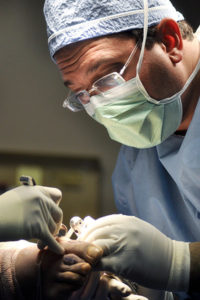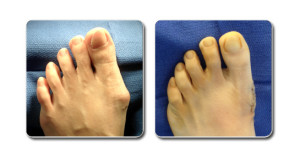 If you’re unfortunate enough to suffer from bunions, or any podiatric condition, then you know how difficult they can make walking, exercising and performing other daily activities. Although bunions may be treated in a variety of methods, alleviating the pain and discomfort associated with bunions often requires undergoing a surgical procedure. This is where the Beverly Hills podiatrists at La Peer Health Systems can help.
If you’re unfortunate enough to suffer from bunions, or any podiatric condition, then you know how difficult they can make walking, exercising and performing other daily activities. Although bunions may be treated in a variety of methods, alleviating the pain and discomfort associated with bunions often requires undergoing a surgical procedure. This is where the Beverly Hills podiatrists at La Peer Health Systems can help.
Feet are responsible for getting you from place to place, and a deformity of the foot can have a profound impact on your quality of life. In Los Angeles, where the mild climate makes it possible to wear open-toe shoes year-round, the presence of bunions can be especially frustrating! Contact us today at 855.360.9119 to schedule a consultation.
Identifying a Bunion
Recent research indicates more than one-third of adults have at least one bunion. It may be inherited, or it may be the result of wearing shoes with elevated heels or a narrow toe-box. Studies also show most individuals who experience bunions suffer foot, hip, lower back and knee pain. If a bunion goes unaddressed, it may cause ongoing pain and limit a person’s mobility.
What does a bunion look like? A bunion is commonly viewed as an abnormal growth on the base of the big toe and forms at the joint between the big toe and the first bone in the foot. Bunions are bumps comprised of bone and soft tissue that occur on the inside of the foot.
What most people don’t realize, however, is a bunion is a structural problem. When a bunion occurs, it causes the big toe joint to become subluxed and move toward the smaller toes. Next, a metatarsal (displaced bone) becomes prominent on the inside portion of the foot. This creates an enlarged “knobby” area on the foot that causes pain.
Bunions range in size and severity. A bunion may start as a mild issue and worsen over time. Thus, an individual who detects the initial signs of a bunion should address this problem before it escalates.
What Causes Bunions?
Bunions can be caused by a number of factors, though they are most commonly the results of hereditary factors that control muscle and tendon balance and function. Wearing ill-fitting shoes that squeeze the toes can accelerate bunion development. Over time, the big toe is pulled toward the second toe. Without treatment, bunions can become painful and unsightly and, if left untreated, can cause arthritis of the big toe joint.
How to Prevent Bunions
A proactive approach to bunion prevention is key. Some of the best ways to reduce the risks of bunions include:
- Choose the right footwear. Shoes that provide plenty of space, low or flat heels and good arch supports are ideal. Also, avoiding tight, narrow or high-heeled shoes enables a person to alleviate pressure on the toe joint that otherwise may lead to bunions.
- Avoid excessive pronation. Pronation, i.e. rolling inward of the foot, increases the risk of bunions. To address this problem, supportive shoes or arch supports are essential. Or, in some instances, a doctor may recommend custom shoe inserts.
- Be aware. Understanding the risks associated with bunions can make a world of difference. If a person believes he or she is dealing with bunions, there is no need to wait to address the issue. Instead, consult with a podiatrist to receive a proper diagnose and determine the best course of action.
Do Bunions Ever Go Away on Their Own?
Unfortunately, bunions won’t go away on their own. Bunions generally become more difficult to remove over time. This means the longer a person waits to address a bunion, the worse it will become.
TREATING BUNIONS
Mild cases of bunions may be controlled with non-surgical treatments like medication, orthotics, and physical therapy. However, if you’re experiencing serious discomfort as a result of your bunion, you may require surgery to correct the problem. The only way to know for certain if surgery is right for you is to schedule an appointment with an experienced podiatrist. Our board-certified surgeons can meet with you to determine if you are a good candidate for outpatient bunion surgery. Most procedures will allow the patient to walk the same day of surgery with an assistive boot after surgery.
Preparing for Bunion Surgery
A doctor will help a patient prepare for bunion removal surgery. By doing so, a doctor will ensure all of a patient’s concerns and questions are addressed prior to treatment.
Initially, a doctor will request medical tests to assess a patient’s overall health. These tests include an X-ray to evaluate the lungs, an electrocardiogram (EKG) to analyze the heart function and blood and urine assessments to identify any underlying illnesses.
Prior to bunion surgery, a patient will need to stop taking aspirin or other blood-thinning medications. A patient also should disclose any current medications to his or her doctor to reduce the risk of surgery complications.
A patient may be required to fast in the hours before treatment. The fasting period varies depending on the patient, and a doctor will provide details about how long a patient should go without food and beverages prior to surgery.
BUNION SURGERY
 If non-surgical treatments fail to alleviate your pain, then bunion surgery might be your best option for finding lasting relief. One of the most common types of bunion surgery is a bunionectomy, which is an outpatient procedure to remove the bunion.
If non-surgical treatments fail to alleviate your pain, then bunion surgery might be your best option for finding lasting relief. One of the most common types of bunion surgery is a bunionectomy, which is an outpatient procedure to remove the bunion.
While you are anesthetized, a surgeon will make a small incision at the top of the large toe or on the side of the foot. The surgeon then removes the bump along with a tiny piece of the bone, allowing the joint to be realigned. Screws, pins, or plates may be used to hold the bone in its new position. The surgeon may also shorten or tighten any loose tendons and ligaments.
After surgery is complete, the doctor will close the incision with absorbable sutures and wrap the foot in a special sterile bandage.
What to Expect After Bunion Surgery
When considering bunion surgery, it’s important to go into the experience with realistic expectations. Most patients who undergo surgery will enjoy a great deal of relief from their bunion pain. They will also notice a reduction in swelling and improvement in big toe alignment and motion.
However, patients should not expect their shoe size to decrease as a result of bunion surgery. Further, continuing to wear tight or ill-fitting shoes without the use of corrective orthotics can actually cause bunions to reappear!
Bunion Surgery Recovery
After bunion surgery, a patient can expect to spend a few weeks recovering. During this time, he or she may experience swelling and discomfort, though this is usually treated effectively with over-the-counter medications. Patients may also need to use crutches or a walking boot, which accommodates the surgical bandages and helps the patient get around. Your LA Peer surgeon will let you know when you may resume normal activities.
Initial recovery after bunion surgery requires approximately six to eight weeks. On average, the full recovery period following treatment lasts about four to six months.
In the first few weeks after surgery, a patient will be required to wear a surgical cast or boot to protect the foot. A patient should also take extra care to avoid getting any surgical stitches wet.
Once a doctor removes a patient’s cast or boot, the patient will need to wear a support brace to help the foot heal. A patient won’t be able to put weight on his or her foot at first, and as such, may require assistance to move around. As the healing process progresses, a patient can start to put weight on the foot. A patient may use a walker or crutches for support as well.
Ultimately, a patient should try to stay off his or her feet as much as possible in the first few weeks after surgery. The foot and toe should be iced to reduce inflammation as necessary. Within one to two weeks of treatment, a patient should be able to drive again.
The foot may stay swollen for several months following surgery. Wearing shoes that provide sufficient space can help minimize the risk of foot swelling. Also, women should avoid wearing high heels for approximately six months after treatment.
Patients should not expect their shoe size to decrease as a result of bunion surgery. Further, continuing to wear tight or ill-fitting shoes without the use of corrective orthotics may actually cause bunions to reappear.
In some cases, a doctor may recommend physical therapy. For those who require physical therapy, they can learn various exercises to strengthen the foot and lower leg.
Bunion removal surgery has a high success rate. A doctor will ensure a patient receives expert insights to help him or her achieve the best possible results.
Find a Bunion Surgeon in Los Angeles
If you are experiencing pain or discomfort associated with bunions, don’t hesitate to contact a specialist. At La Peer Health System’s Podiatry Department, we employ a highly experienced team to help with all your foot health needs and are widely regarded as one of the best foot surgery centers in the country. Our website has the most extensive before and after photo gallery than anywhere on the internet displaying our outcomes.
Please feel free to call us at 855-360-9119 or contact us online to discover the La Peer difference firsthand! You can also find out more information about bunionectomies on our Bunion Surgery Center website.
Next, read about Cosmetic Foot Surgery.
